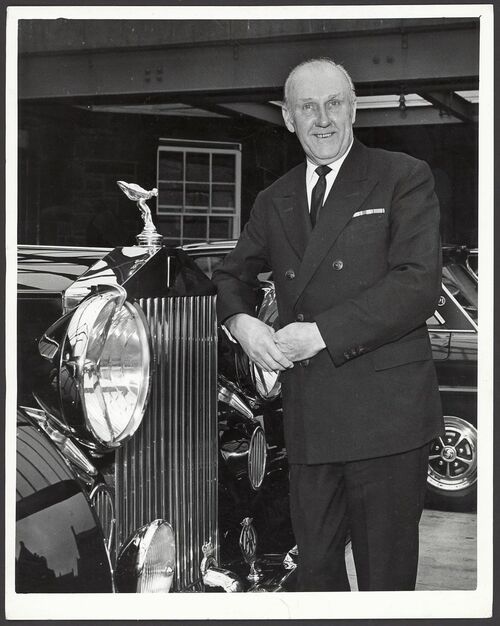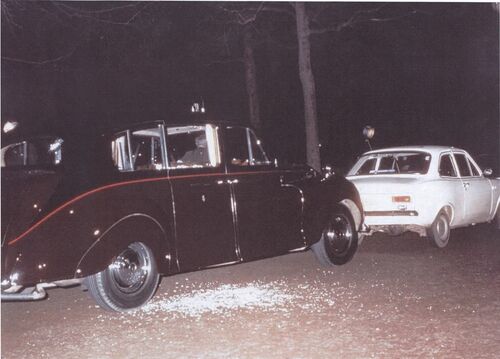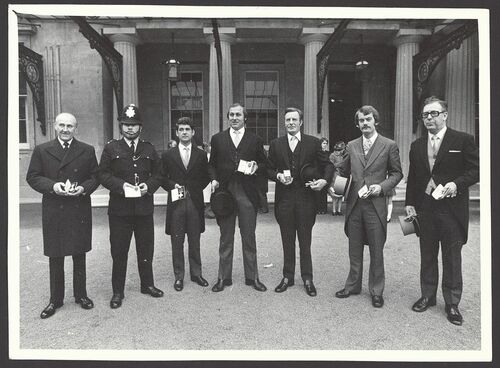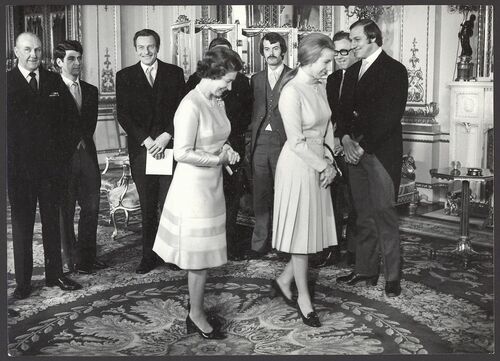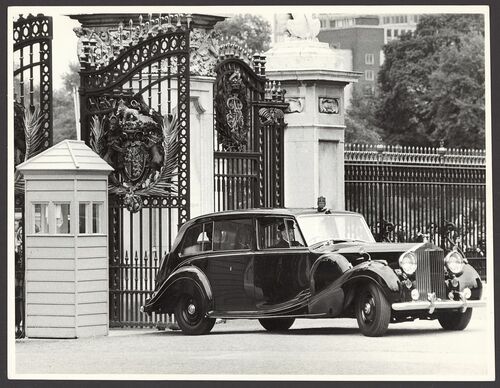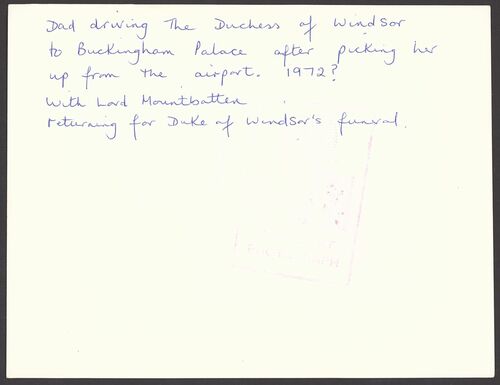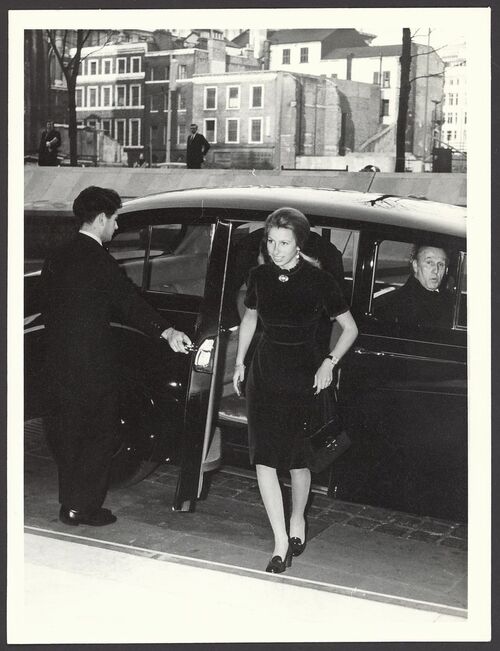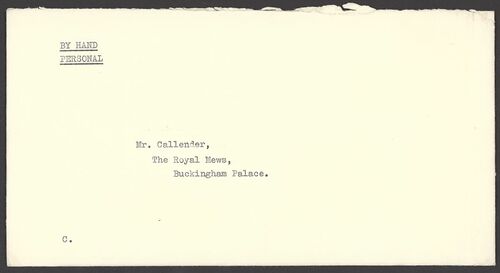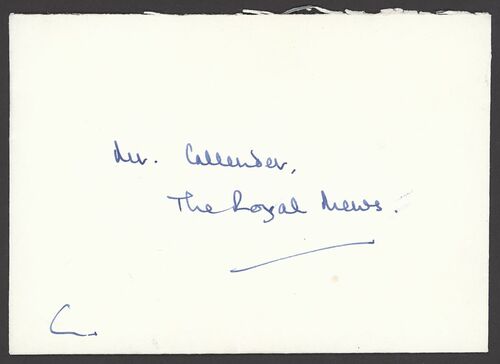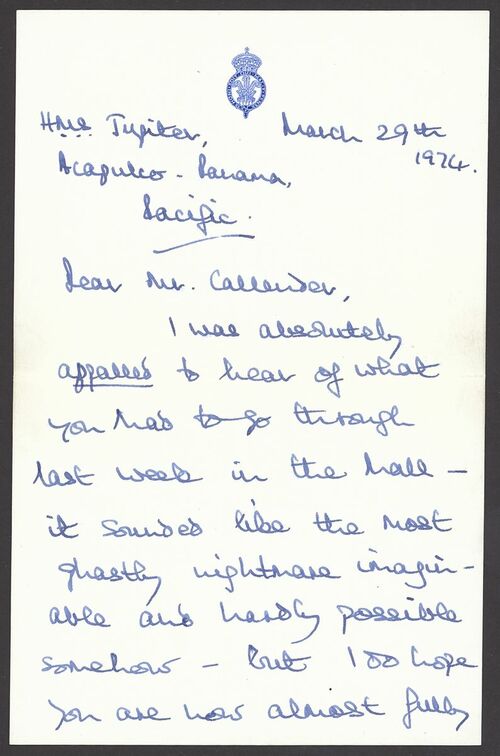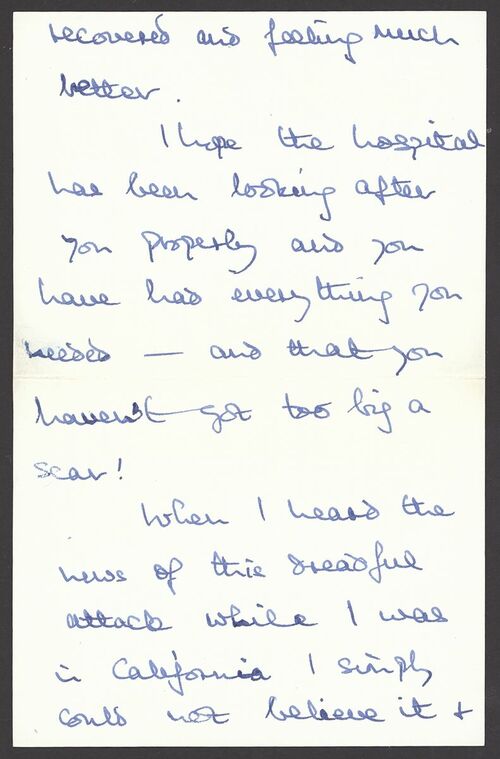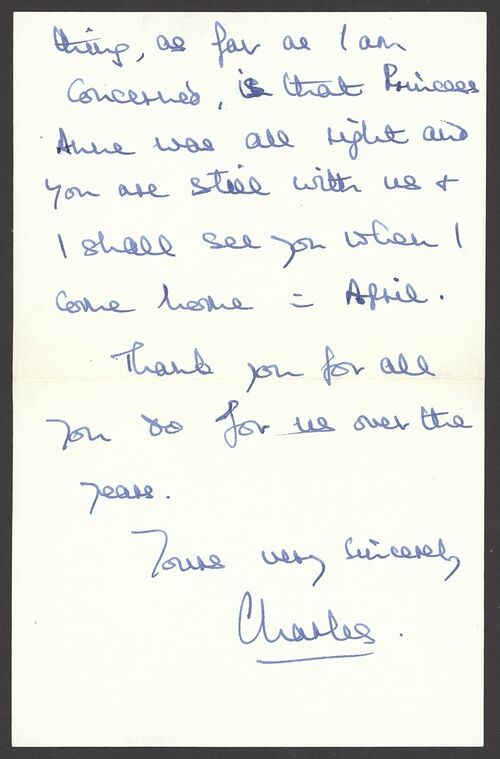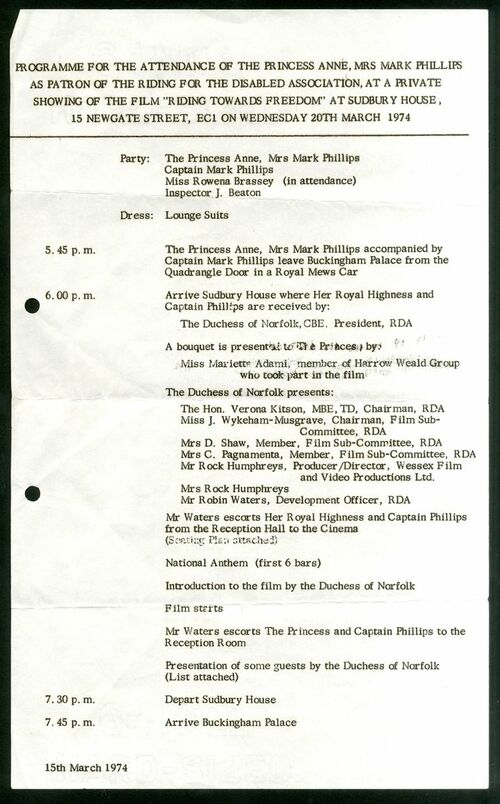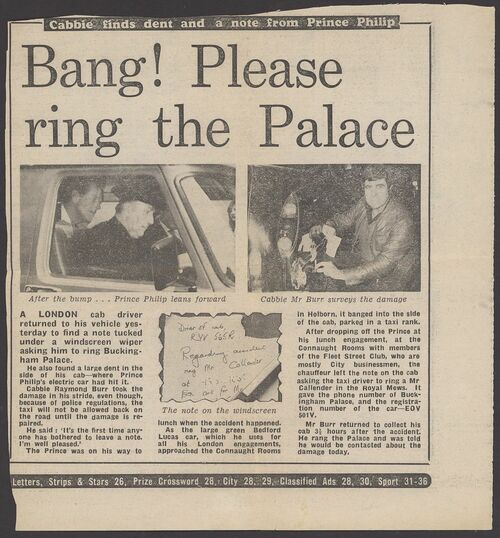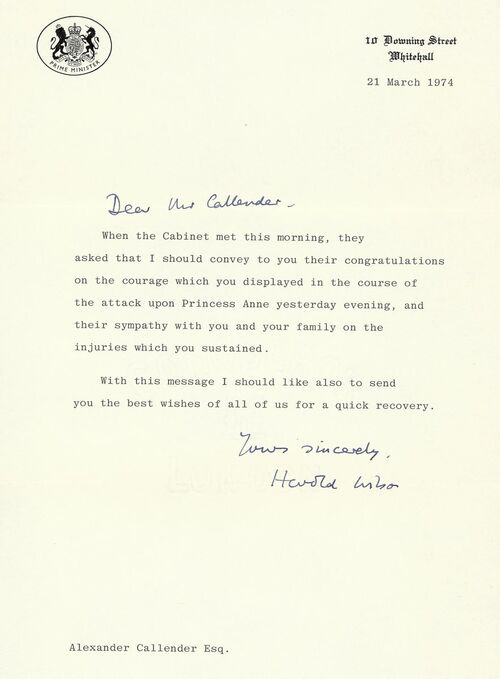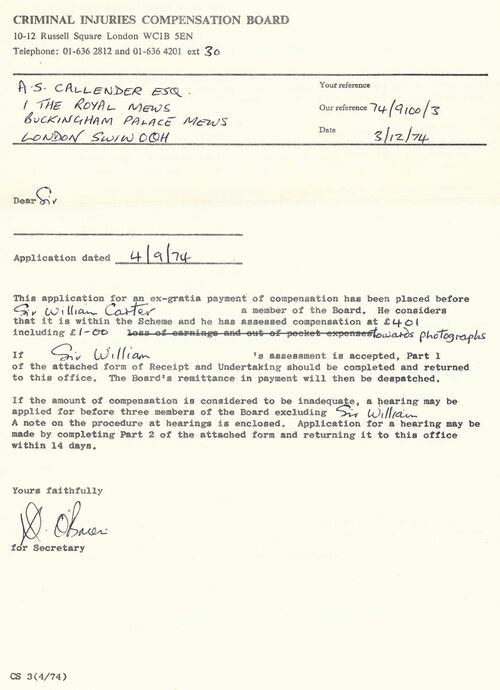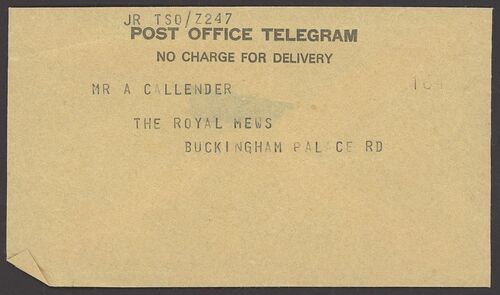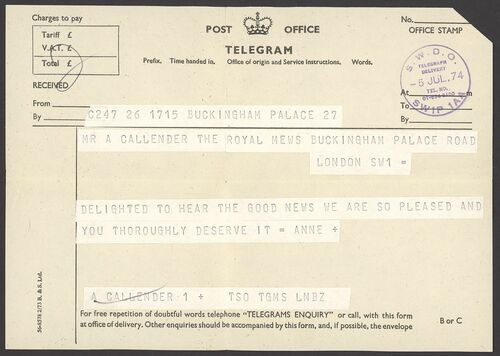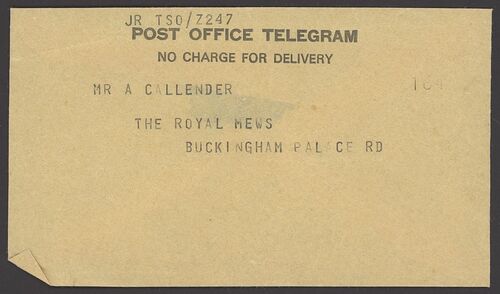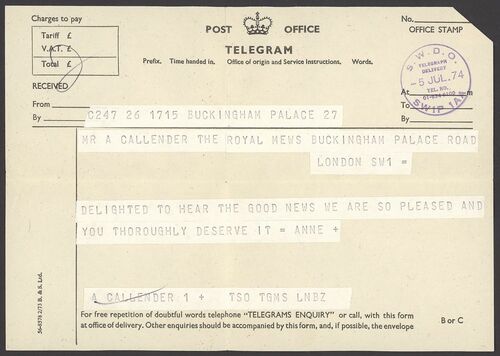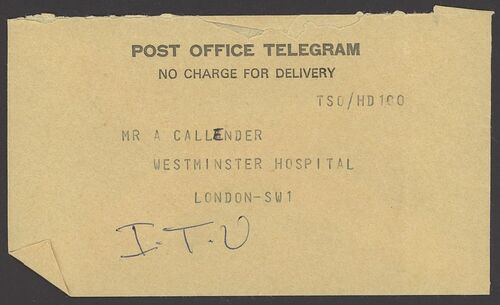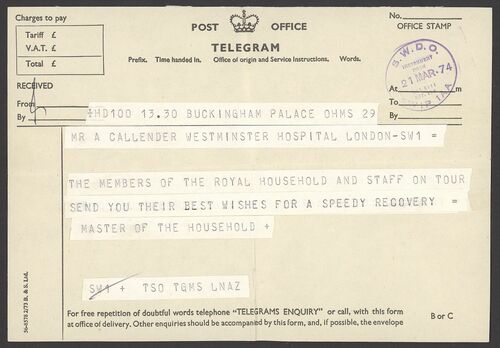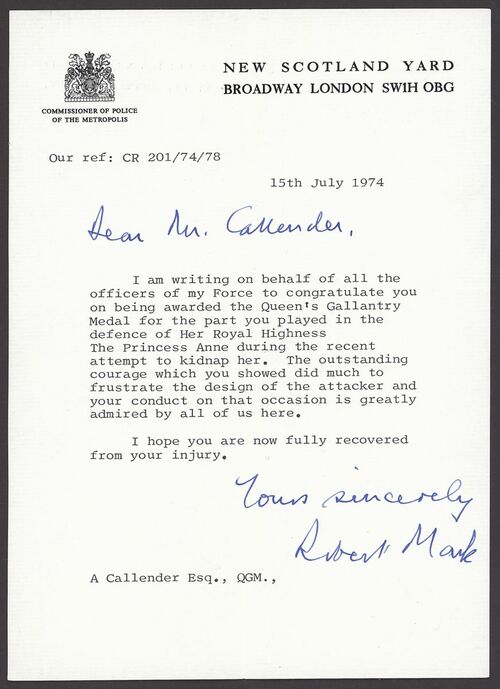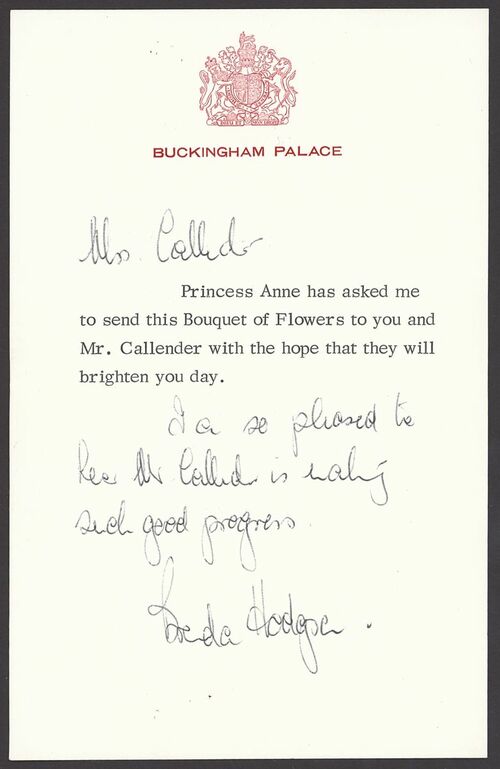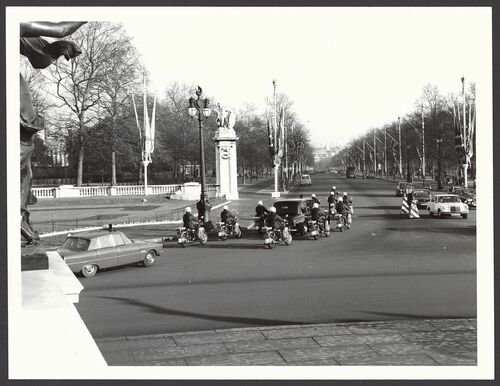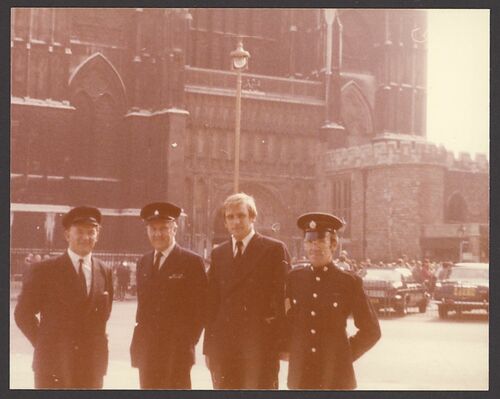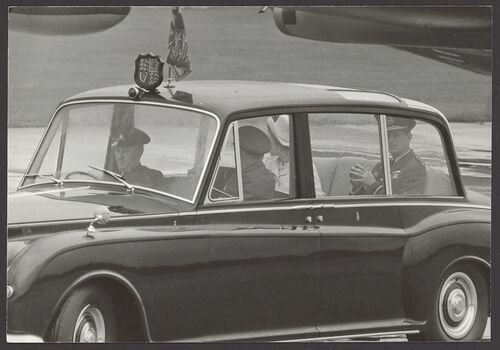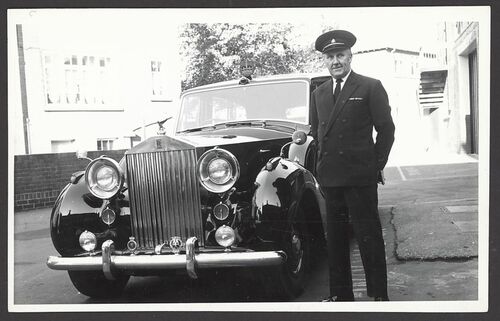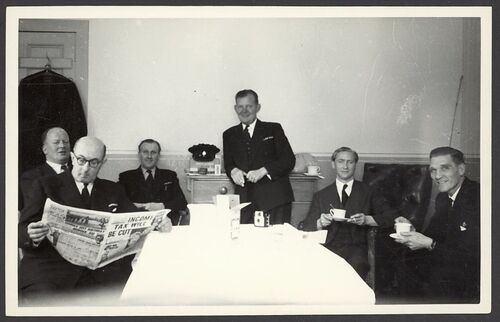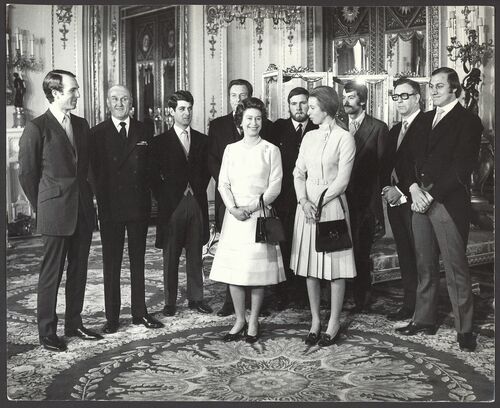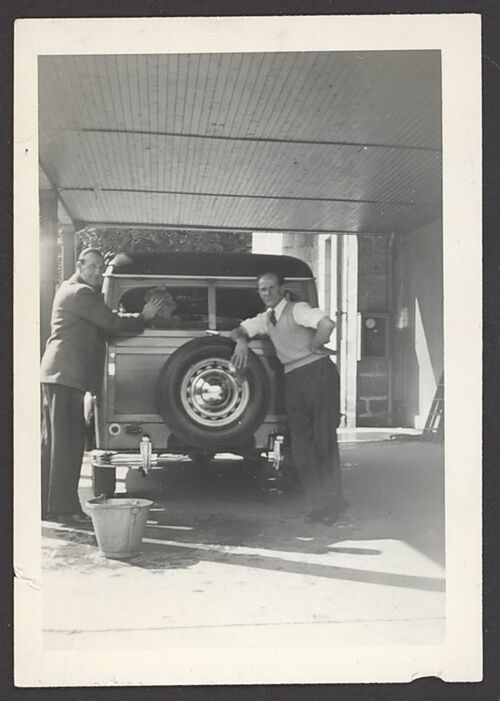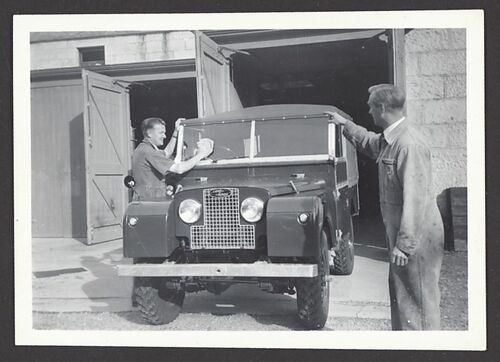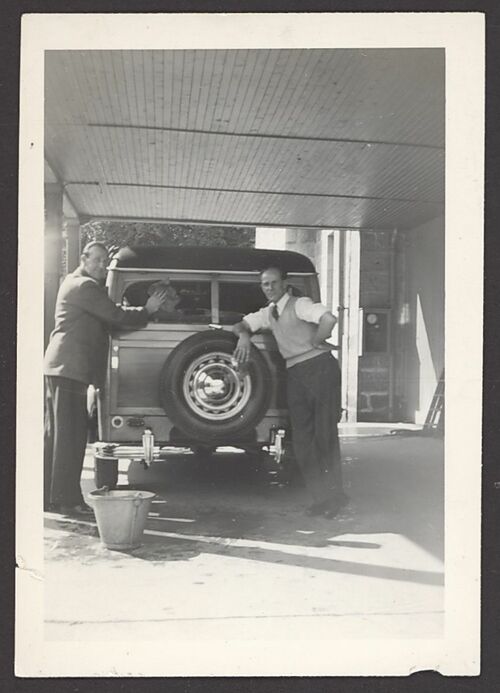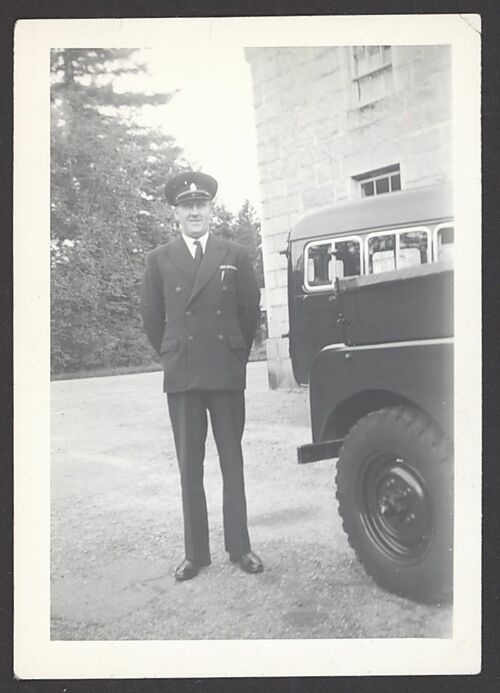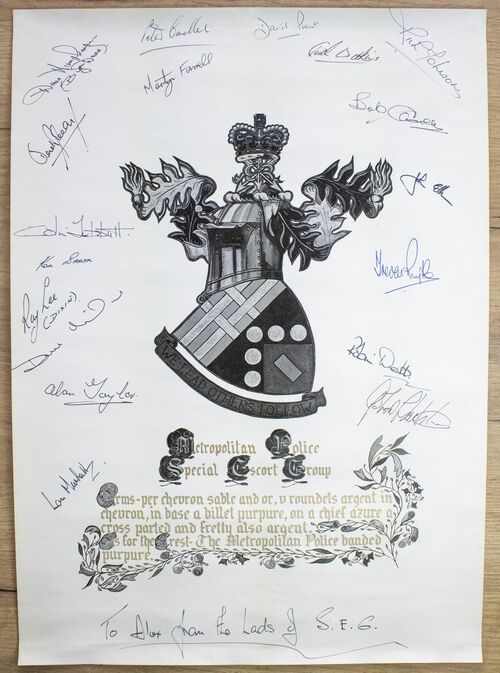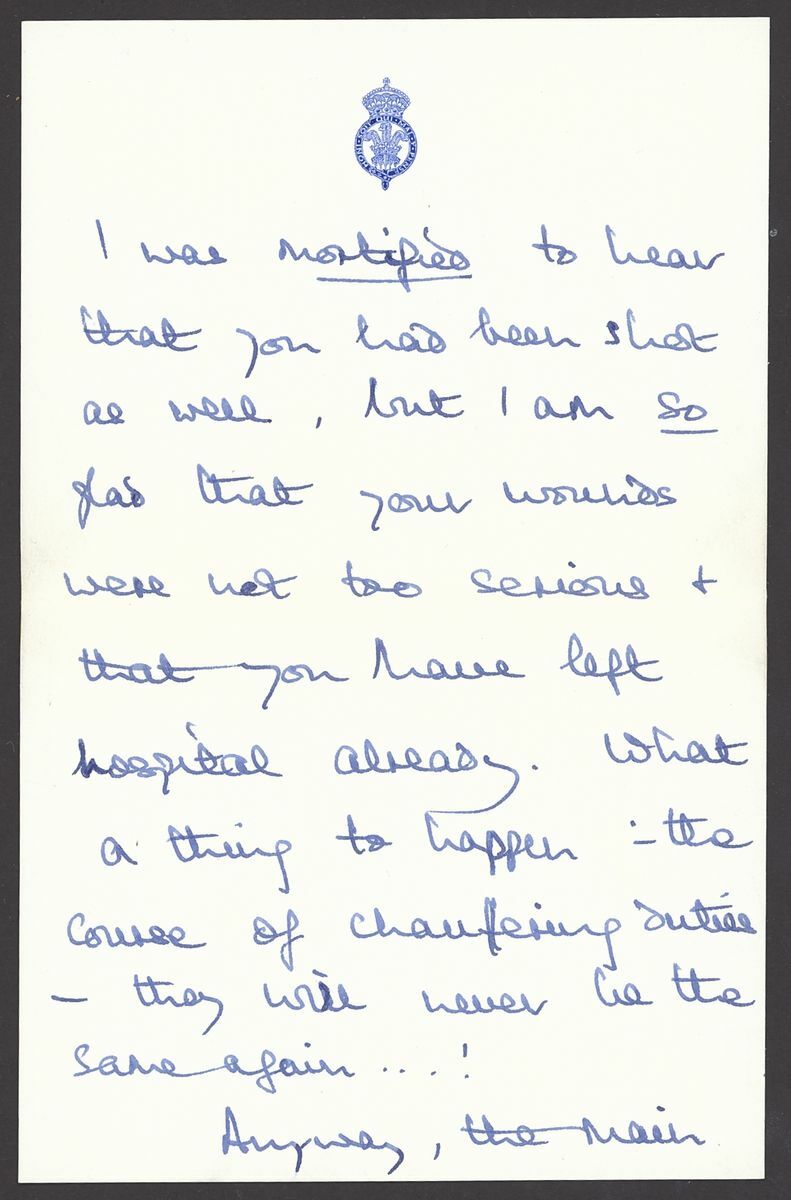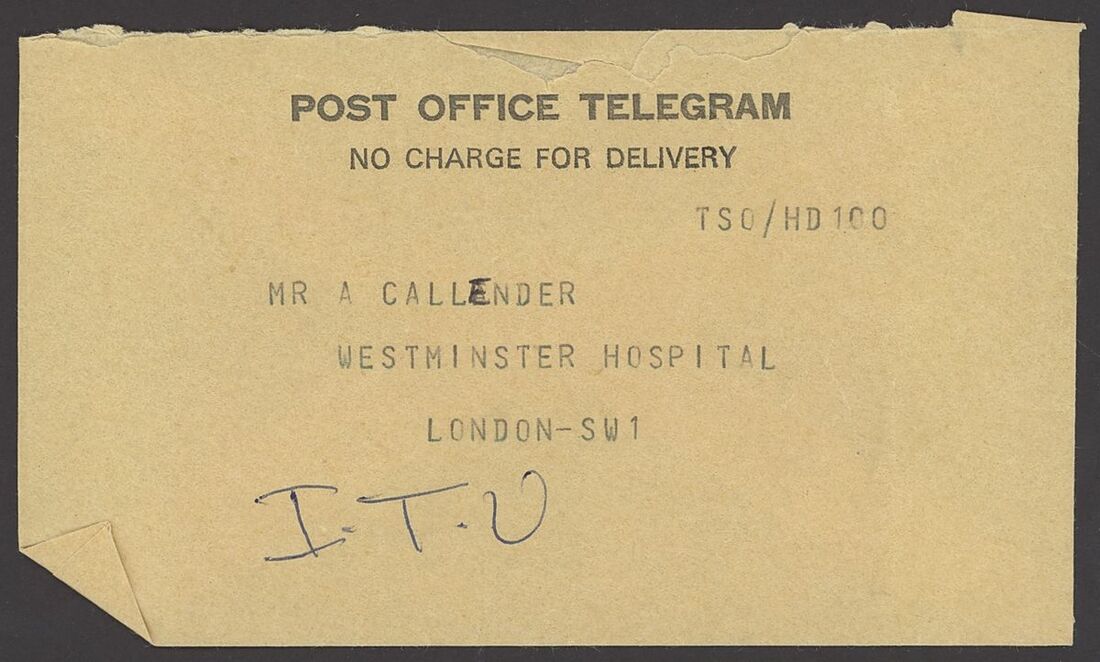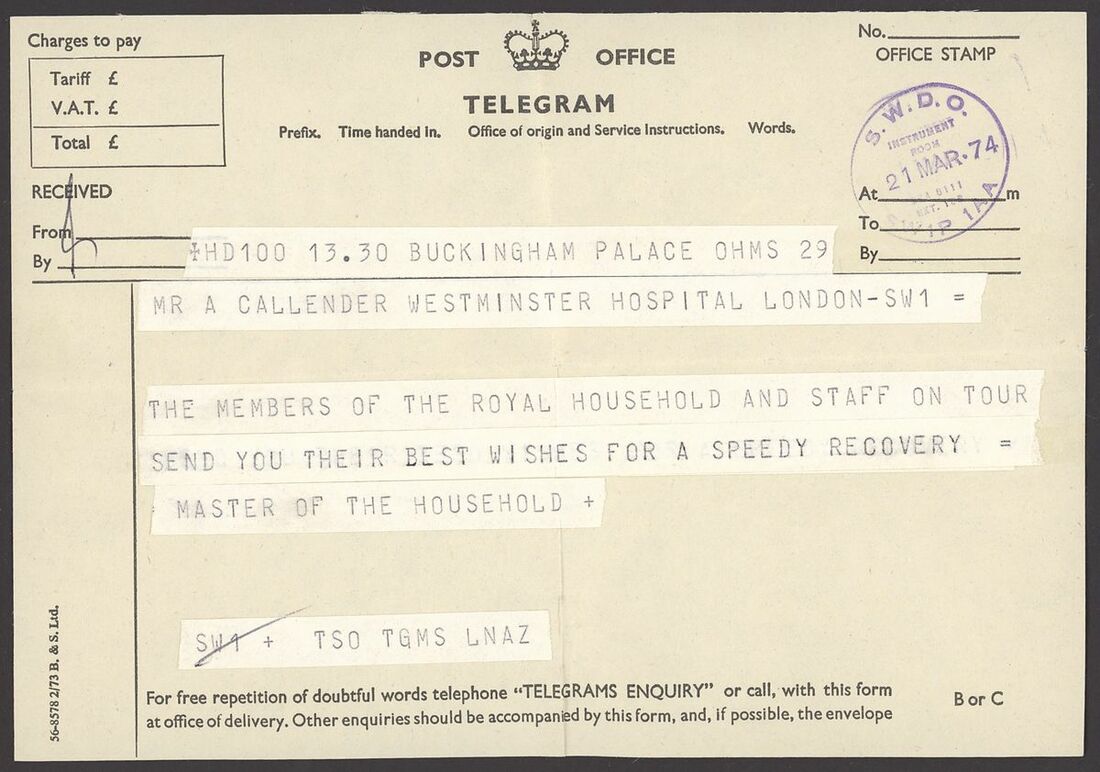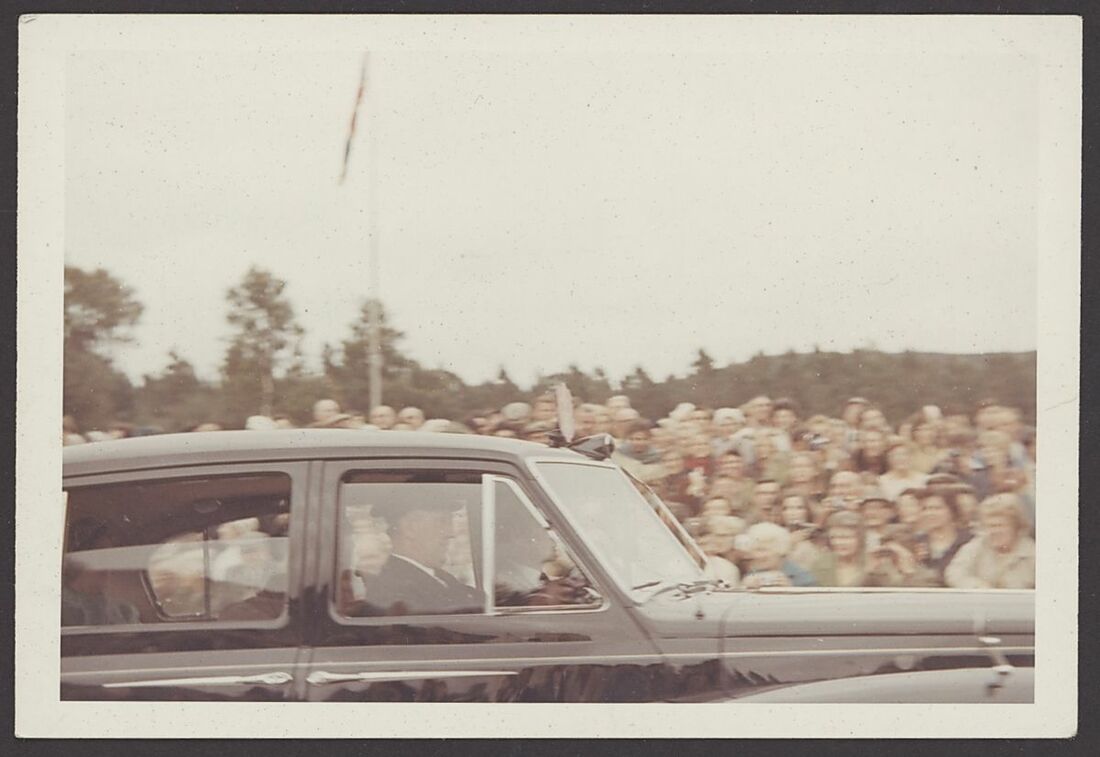Auction: 23003 - Orders, Decorations and Medals
Lot: 219
Sold by Order of the Callender Family
'I'm absolutely delighted to receive the Q.G.M....I don't remember that much about the incident on The Mall but before I was taken to hospital I remember the Princess asking me how I felt. She was a real trouper.'
Chauffeur Callender, selfless as ever
The important and well-documented Q.G.M., R.V.M. group of fourteen awarded Chauffeur A. S. Callender, Royal Household, late Driver, Royal Corps of Signals
Callender was the driver for H.R.H. The Princess Anne during the crazed kidnap attempt made on her on The Mall, London, on the evening of 20 March 1974; when his Austin Princess was blocked in the final moments of their journey, Callender came face-to-face with Ian Ball - who would be jailed for life for the attack - who put a loaded gun to his head in the attempt on the Princess who sat in the back
Despite this, he gallantly sprang out of the car and attempted to disarm him, the result being his taking bullet to the chest; he was duly rewarded with the first Q.G.M. to ever be Gazetted, besides winning the 'Chauffeur of the Year Award' for his bravery for good measure; Callender devotedly served the Royal Family for nearly three decades and shared in some of the most famous events of that period
Queen's Gallantry Medal (Alexander Callender), in its Royal Mint case of issue; Royal Victorian Medal, silver issue, E.II.R., in its Royal Mint case and outer card box of issue; 1939-45 Star; Africa Star; Defence and War Medals 1939-45, these last four in their card box of issue addressed to 'Mr. A. Callender, 35 Ebury Buildings, Ebury Square, Victoria, SW1' and with Army Council enclosure confirming '4'; Jubilee 1977, in its Royal Mint case of issue; Royal Household Faithful Service Medal, E.II.R., the suspension dated '1954-1974' (Alexander Callender), in its Royal Mint case of issue; Germany, Medal of the Order of Merit of the Federal Republic of Germany, gilt and enamel, by Steinhauer & Luck, Ludenscheld, in its case of issue; Luxembourg, Medal of the Order of Adolphe of Nassau, silvered, in its case of issue; Malaysia, Medal of the Order of The Defender of The Realm, silver, by P. H. Hendry, Kuala Lumpur, in its case of issue with card insert stating 'Mr A. Callender PPN'; Norway, Kingdom, Olav V Merit Medal, silver-gilt, by Den Kongelige Mynt, Kongsberg, in its case of issue, the case with label stating 'Gull med. Mr A. Callender'; Nepal, Kingdom, Merit Decoration, Silver Medal, in case of issue, the lid with label stating 'State Visit Nov. 18th 1980 King & Queen of Nepal'; Portugal, Merit Medal, silver, in its Frederico Costa, Lisbon case of issue; Sudan, Merit Medal, gilt, in its card box of issue with card stating 'Mr. A. Callender', all housed within embossed E.II.R. card box, with its card insert, having previously housed the 1967 Christmas Pudding from The Queen and Duke of Edinburgh, nearly extremely fine (Lot)
Since 20 June 1974 - when it replaced awards in the Order of the British Empire ‘for Gallantry’ - the Queen’s Gallantry Medal has been the United Kingdom’s third level award for bravery, after the George Cross and the George Medal. At the time of print, it has been awarded on 1,101 occasions - 559 to civilians and 542 to military personnel. With the passing of HM The Queen, the award has been renamed the King's Gallantry Medal. Given the line of succession, it will be some time before we might see another award of the Queen's Gallantry Medal.
The award to Callender is a landmark award, given that it was the first Gazette of award and his name appears as the first to be awarded the Medal, in an edition which included five other examples. The fact that the action is one of only two occasions in which all four levels of gallantry have been earned by civilians is also worthy of mention (For Exemplary Bravery, Nick Metclafe MBE QGM, refers).
Q.G.M. London Gazette 27 September 1974 (to be dated 5 July 1974): Chauffeur Alexander Callender, Royal Household (in a joint citation with Inspector James Wallace Beaton, Metropolitan Police [awarded the George Cross]; Police Constable Michael John Hills, Metropolitan Police; and Ronald George Russell, Area Manager, Exclusive Office Cleaning, London E2 [both awarded the George Medal]; Police Constable Peter Roy Edmonds, Metropolitan Police; and Mr. John Brian McConnell, Freelance Journalist [both awarded the Queen’s Gallantry Medal]; and Mr. Glenmore Thomas Walter Martin, Chauffeur [awarded the Queen’s Commendation for Brave Conduct]):
‘At about 8:00 p.m. on 20 March 1974, Her Royal Highness The Princess Anne and Captain Mark Phillips were returning to Buckingham Palace from an official engagement. Their car was being driven by Mr. Callender and they were accompanied by Princess Anne’s personal Police Officer, Inspector Beaton, and her Lady-in-Waiting. As the Royal car approached the junction of the Mall with Marlborough Road, a white car swerved in front of it, causing Mr. Callender to stop suddenly. Leaving the vehicle, the driver went to the Royal car and Inspector Beaton, who was seated in the front passenger seat, got out to see what was wrong.
As Inspector Beaton approached, the man pointed a revolver at him and fired, wounding him in the shoulder. Despite his wound, the Inspector drew his pistol and fired at the man, but the shot missed. He was unable to fire again as his gun jammed, and as he moved to the nearside of the car and tried to clear the stoppage the gunman told him to drop his weapon, or he would shoot Princess Anne. As he was unable to clear the weapon the officer placed it on the ground. The gunman was trying to open the rear offside door of the Royal car and was demanding that Princess Anne went with him, but Princess Anne and Captain Phillips were struggling to keep the door closed. As soon as the Lady-in-Waiting left by the rear nearside door Inspector Beaton entered the same way, and leant across to shield Princess Anne with his body. Captain Phillips managed to close the door and the Inspector, seeing that the man was about to fire into the back of the car, put his hand up to the window directly in the line of the fire to absorb the impact of the bullet. The gunman fired, shattering the window, and the officer was wounded in the right hand by the bullet and by broken glass. Despite his wounds the Inspector asked Captain Phillips to release his grip on the door so that he might kick it open violently to throw the man off balance. However, before he could do so, the man opened the door and fired at the officer again, wounding him in the stomach. The Inspector fell from the offside door and collapsed unconscious at the gunman’s feet.
Mr. Callender meanwhile had tried to get out of the car, but the gunman had put the pistol to his head and told him not to move. Undeterred, he got out of the car at the first opportunity and grabbed the man’s arm in an attempt to remove the gun. Although the gunman threatened to shoot him, Mr. Callender clung to the man’s arm until he was shot in the chest.
Mr. McConnell was travelling in a taxi along the Mall when he heard shots. As a Royal car appeared to be involved, he stopped the taxi and ran back to the scene, where he found the gunman shouting at the occupants of the car. Seeing the gun in the man’s hand, Mr. McConnell went up to him in a placatory manner and asked him to hand over the gun. The man told him to get back, but when Mr. McConnell continued to approach he took aim and fired, wounding him in the chest. Mr. McConnell staggered away and collapsed.
Constable Hills was on duty at St. James’s Palace when he heard a noise and saw the cars stationary in the Mall. Thinking there had been an accident, he reported by personal radio and went to the scene. He saw a man trying to pull someone from the back of the car and touched his arm, whereupon the man spun around, moved a few feet away, and pointed the gun at the officer. As Constable Hills moved forward to take the gun, the gunman shot him in the stomach and returned to the rear of the car. The officer staggered away and, using his personal radio, sent a clear and concise message to Cannon Row Police Station reporting the gravity of the situation and calling for assistance. As he walked round the back of the car he saw Inspector Beaton’s discarded gun, and picking it up returned to the offside of the vehicle intending to shoot the gunman. However, he felt very faint and did not use the weapon as he could not be sure of his aim. He was assisted to the side of the road where he collapsed.
Mr. Martin was also driving along the Mall and when he saw the situation, he drove his motor car in front of the gunman’s car to prevent any possible escape. He then went to the Royal car to render assistance, but the gunman pushed a gun in his ribs. At this point Constable Hills intervened and was shot, and it was Mr. Martin who assisted him to the side of the road.
Mr. Russell was driving along the Mall when he saw the gunman attempting to open the door of the Royal car. He stopped and as he ran back he heard shots. Arriving at the car, he saw the man with the gun in his hand and Police Constable Hills being assisted to the side of the road. Regardless of the obvious danger, and seeing that the gunman was holding Princess Anne by the forearm and trying to wrest her from the car, Mr. Russell ran up and punched him on the back of the head. The man immediately turned around and fired at him, but fortunately the shot missed. Mr. Russell then tried to get Constable Hills’ truncheon, but hearing more commotion he returned to the Royal car from which the gunman was still trying to drag Princess Anne with one hand, while pointing a gun at her with the other and threatening to shoot if she refused to come. While maintaining her refusal, Princess Anne managed to delay the gunman and to distract his attention by engaging him in conversation. Captain Phillips kept his arm firmly round her waist and was trying to pull her back into the car. Mr. Russell now ran around to the other side of the car, and saw that Princess Anne had broken free from the gunman and was about to leave by the nearside door. She was almost out of the car when the gunman came up behind Mr. Russell and once again tried to reach Princess Anne. Captain Phillips promptly pulled her back into the car and Mr. Russell punched the man on the face. At this point other police officers began to arrive in response to Constable Hills’ call for assistance and the gunman ran off.
Constable Edmonds was one of the first police officers on the scene, and he saw the gunman running away with the gun still in his hand. Without hesitating the Constable gave chase shouting to the gunman to stop, but the man continued to run and pointed the gun directly at the officer. Completely undeterred, the Constable charged the man and knocked him to the ground. Other police officers who had also given chase immediately threw themselves on the man and disarmed him.
The wounded men were all taken to hospital, where bullets were removed from Inspector Beaton, Mr. Callender, and Mr. McConnell. Constable Hills received treatment for his wound, but no attempt has been made to remove the bullet from his liver.
All the individuals involved in the kidnap attempt on Princess Anne displayed outstanding courage and a complete disregard for their personal safety when they each faced this dangerous armed man who did not hesitate to use his weapon. It is entirely due to their actions - as well as to the calmness, bravery, and presence of mind shown by both Princess Anne and by Captain Mark Phillips in circumstances of great peril - that the attack was unsuccessful.’
Princess Anne was made a D.C.V.O., Captain Peter Phillips a C.V.O. and Miss Rowena Brassey an M.V.O. as a result.
R.V.M. (Silver) London Gazette 11 June 1977.
Alexander Small Callender was born at Edinburgh on 20 June 1918 but lost his father whilst an infant, for he was killed in action with the 4th Battalion, Royal Scots in September 1918. Young Callender was working as an apprentice French polisher and joined the Royal Corps of Signals on 25 January 1937 after the workshop that he held employment was burned down. During the Second World War he served in Egypt from 28 January 1938-5 February 1944, as a Driver for the War Office and thence in Norway from 3 July-27 August 1945. Upon his Release in March 1946, the was given the following Testimonial:
'This solider is of an amiable disposition, who has a capacity for work and has given his best at all times. A first class driver with a considerable knowledge of mechanics he has looked after his vehicles in a most satisfactory manner at all times. Honest, sober and always truthful he is a man on whom reliance can be placed.'
Callender joined the Royal Household in 1954 and in the period that followed gave the best part of thirty years devoted service to the Royal family. He shared in some of the most famous events of the period in a personal capacity, having an important role to deliver at State Events, weddings and State Visits. This is all besides the day-to-day transport requirements for the working members of the Royal Family.
On the evening of 20 March 1974 he was at the wheel of the Royal maroon Austin Princess, the party comprising Princess Anne - at the time the undoubted ‘celebrity’ member of the Royal Family: a talented equestrian athlete, she had won the 1971 BBC ‘Sports Personality of the Year’ award, and her recent wedding had been watched by a global television audience of 500 million - Captain Mark Phillips, Miss Brassey and Inspector Beaton. He drove them from the Quadrangle Door of Buckingham Palace at 1745hrs to Sudbury House, 15 Newgate Street for a Private Showing of the film Riding Towards Freedom, in her role as Patron of the Riding for the Disabled Association. Having departed on time at 1930hrs and safely making their way back to Buckingham Palace, fate would cross his path and alter his life forever.
His path was blocked by a white Ford Escort. The attempted kidnapper, Ian Ball, had been armed with a .22 revolver and a .38 revolver, and was carrying four pairs of handcuffs and a ransom letter.
In the events that followed, perhaps best summarised by the detailed citation reproduced above, Callender did all he could to protect the Princess but found himself shot in the chest and subsequently carted off to Westminster Hospital. His family feared the worst but he pulled through. Initially ordering the Princess to come with him, Anne gave her own three words in reply:
'Not bloody likely.'
The morning after the attack, Mrs Callender received the following Royal Court Telegrams at 1100hrs:
'Deeply shocked to hear of your husband's injury. My deepest sympathy and I do hope he will be better soon. CHARLES.'
Another:
'So shocked and appalled by last nights disaster I just wanted to send you my thoughts and sympathy. Sincerely, SNOWDON.'
Amongst a plethora of other letters (including cards from the Chefs of the Royal Kitchen and the Special Escort Group), telegrams and flowers which came in, Princess Anne herself sent a bouquet to his wife. The Prime Minister, Harold Wilson, wrote:
'When the Cabinet met this morning, they asked that I should convey to you their congratulations on the courage which you displayed in the course of the attack upon Princess Anne yesterday evening, and their sympathy with you and your family on the injuries which you sustained.'
Perhaps the most striking, written on 29 March, came from (the then) Prince of Wales:
'HMS Jupiter, Acapulco-Panama. Pacific.
Dear Mr Callender,
I was absolutely appalled [underlined] to hear of what you had to go through last week in The Mall - it sounded like the most ghastly nightmare imaginable and hardly possible somehow - but I do hope you are almost fully recovered and feeling much better.
I hope the hospital have been looking after you properly and you have had everything you needed - and that you haven't got too big a scar!
When I heard of the dreadful attack while I was in California I simply could not believe it + I was mortified [underlined] to hear that you had been shot as well, but I am so [underlined] glad that your wounds were not too serious + that you have left hospital already.
What a thing to happen - the course of chauffeuring duties - they will never be the same again...!
Anyway, the main thing, as far as I am concerned, is that Princess Anne was all right and you are still with us + I shall see you when I come home in April.
Thank you for all you do for us over the years.
Yours very sincerely, CHARLES.'
Ball subsequently stood trial at the Old Bailey. Found guilty, he was sentenced to life imprisonment for the attempted murder of Inspector Beaton and other offences. The motive for the kidnap was the £3 million ransom that he hoped to extract.
Callender was officially notified of the award at the start of July 1974, and on 5 July received the following telegram from Buckingham Palace to him, by then back at the Royal Mews:
'Delighted to hear the good news we are so pleased and you thoroughly deserve it. Anne.'
He returned to work driving The Queen on her visit to Scotland and thence joined the ‘magnificent seven’ to be presented with their awards by H.M. The Queen at an Investiture at Buckingham Palace on 26 November 1974, and afterwards all seven had a private reception with the Queen, Princess Anne, and Captain Phillips. A humourous story is related of how one of Callender's children commented on the Archbishop of Canterbury, looking like Father Christmas, whilst decked out in his finery. This was related to The Queen and the Princess, whose joy and humour at such a charming moment was captured by the photographer on duty.
That year Callender also picked up the Chauffeur of the Year award from the British Chauffeurs Association and a silver Presentation Goblet from the Evening News & St George's Taverns for his Patriotism on that day. He was provided a cheque from the Royal Household Staff Welfare Fund, £401 from the Criminal Injuries Compensation Board and several cheques from the general public, including £2.50 from '...a student in America', a Mr P. E. T. Gower, of Newhaven, Connecticut.
He remained in the Royal Household and remained a key member of the Chauffeurs at the Mews. Indeed, he was chosen as the driver for the Duchess of Windsor, who returned for the funeral of the Duke of Windsor in June 1972. Many family stories exist of his being the favourite of the late Queen, who adored how smoothly he drove, especially on the many long journeys they shared together. Callender also came to the rescue of The Duke of Edinburgh, who managed to crash into a taxi whilst on his way to lunch in the Connaught Rooms. He was the name scribbled on a note left on the windscreen of the taxi and ensured the cabbie had his repairs seen to. In the following years he also attended many Royal events with his wife and drove Prince Charles and Princess Diana away to their honeymoon. He retired just before his thirtieth year in the service.
Sold together with an important and extensive original archive comprising:
(i)
A full set of Warrants and Certificates for his various awards and Medals, together with invitations to Investiture for the Q.G.M.
(ii)
The letter from Prince Charles, quoted in full above, in his personal envelope addressed 'Mr Callender, The Royal Mews. C.' and in the official Prince of Wales outer envelope, this marked 'By Hand Personal' and additionally marked 'C.', an important unpublished and deeply personal letter.
(iii)
A series of telegrams, including that from the Royal Household, 21 March 1974 and the previously quoted telegram from Princess Anne on the confirmation of his award, 5 July 1974.
(iv)
A series of letters and cards of sympathy and thanks, including that from the Prime Minister, Harold Wilson, the Commissioner of the Metropolitan Police, besides The Hon. Lady Charteris, Margaret 'Bobo' Macdonald, various members of the Royal Household, his friends, family and the general public, the majority with their envelopes (quantity).
(v)
His original programme for 20 March 1974, printed for distribution 15 March 1974 and surely carried on that fateful night.
(vi)
His Soldier's Book, Release Book Class "A" and Certificate of Service, with riband bars.
(vii)
Series of his Driving Licences and Passports, including an International Driving Permit.
(viii)
Chauffeur of the Year Award, glazed and framed, his Evening News & St George's Tavern Presentation Trophy, two pairs of his driving gloves and Metropolitan Police Special Escort Group Certificate, this last signed by 'The Lads of S.E.G.'
(ix)
A series of photographs of his career, together with newspaper cuttings and other related material.
To close, a few words from his son and daughter:
'Dad was an excellent driver. It was in the Army that he learnt to drive, being taught on lorries on Salisbury Plain in the days when you had to double de-clutch.
On one occasion, after driving The late Queen back to London from Sandringham she looked over his shoulder into the car and expressed her surprise that the car had a manual gear box and not the automatic one she was expecting. He took pride in not only being an excellent driver but also having excellent map reading skills and the ability to find locations from memory once he'd worked out his route from a glance at a map.
He was also very conscientious and would do recces in his own time if he ever had to drive somewhere so new that it wasn't on his paper maps.
He was a kind and caring father. My sister and I always had the best polished shoes out of everyone in our class. He would take our shoes from us as soon as we arrived home from school and polish them the way he'd been taught in the Army. His window cleaning skills were also beyond compare. He could clean windows with a sponge and shammy leather so well that you wouldn't think there was any glass in them at all.
He didn't have any hobbies really, and didn't take up golf or fishing in retirement. He supported Hearts FC and used to watch Chelsea play when they were at home and was happy to watch any sport on television. Having spent so much of his time away from home in the Royal Household he enjoyed spending time with his family, especially his two grandchildren as he had missed so much of our childhoods when we were growing up.'
Subject to 20% VAT on Buyer’s Premium. For more information please view Terms and Conditions for Buyers.
Sold for
£40,000
Starting price
£15000



